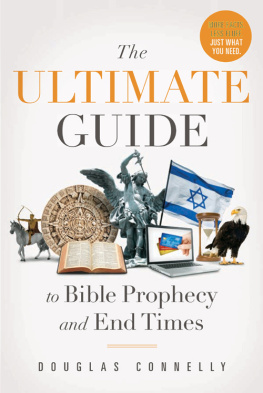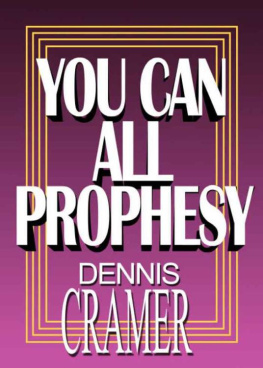
when
prophecy
fails
Leon Festinger was a hugely inspirational social psychologist, and is best known for his theory of cognitive dissonance. He taught at numerous US university including Stanford University. He died in 1989.
Henry W. Riecken was a professor of social psychology at the University of Minnesota when he co-authored When Prophecy Fails. He is the author of Social Experimentation and articles on the general topic of evaluating the effectiveness of educational and social programs.
Stanley Schachters best know work was on emotions. A student of Yale and the University of Michigan in 1949, he taught at Columbia as professor of psychology. He died in 1997.
Elliot Aronson (foreword) is one of the worlds most distinguished social psychologists and has received many awards for scientific research, teaching, and writing. His books include The Social Animal and Mistakes were made (but not by me) . He lives in Santa Cruz, California.
when
prophecy
fails
Leon Festinger
Henry W. Riecken
Stanley Schachter
FOREWORD BY Elliot Aronson

PINTER & MARTIN
When Prophecy Fails
A social and psychological study of a modern group
that predicted the destruction of the world
First published by University of Minnesota Press 1956
This edition published by Pinter & Martin Ltd 2008
Elliot Aronson has asserted his moral right to be identified
as the author of the foreword in accordance with the
Copyright, Designs and Patents Act of 1988
All rights reserved
ISBN 978-1-905177-19-6
British Library Cataloguing-in-Publication Data
A catalogue record for this book is available from the British Library
This book is sold subject to the condition that it shall not, by way of trade and otherwise, be lent, resold, hired out, or otherwise circulated without the publishers prior consent in any form or binding or cover other than that in which it is published and without a similar condition being imposed on the subsequent purchaser
Set in Garamond
Printed and bound in Great Britain by
CPD, Wales
Pinter & Martin Ltd
6 Effra Parade
London SW2 1PS
www.pinterandmartin.com
CONTENTS
Imagine, for a moment, that a group of people are convinced that in a few months a cataclysmic flood will destroy the North American continent. They also believe that, minutes before the catastrophe, a vehicle will arrive from outer space, swoop up this small band of believers, and carry them to safety on a distant planet. Suppose that these people are not wild-eyed kooks wearing white robes and carrying signs saying REPENT! but are intelligent, sensible people with nice homes, loving families, and good jobs. In accordance with their belief, they have quit their jobs and given away their money and possessions (who needs money and possessions on a far-off planet?). Now they are eagerly awaiting the arrival of the spaceship and the beginning of their adventure, which will take place precisely at midnight on December 21. How will these people feel and what will they do on December 22, assuming of course that North America still exists and the spaceship did not arrive?
This question would be interesting to just about anyone. In 1954, though, it was particularly interesting to Leon Festinger, a brilliant young experimental social psychologist who was in the process of inventing a new theory of human behavior the theory of cognitive dissonance which was soon to emerge as the most exciting theory in social psychology. Essentially, the theory defined dissonance as the mental turmoil that is produced when a person holds two ideas that are incompatible: for example, the cognition I know smoking can kill me and the cognition Im smoking two packs a day. Because dissonance is uncomfortable, people will try to reduce it by changing one or both cognitions to make them more consonant with each other. In this case, smokers could either give up cigarettes or justify smoking on some other grounds (smoking reduces my anxiety; it keeps me from overeating). The more important the issue and the greater the degree of a persons commitment to it, the greater the dissonance and the greater the need to reduce it.
When Festinger learned of this doomsday group, by reading an account of Mrs. Keech and her predictions in a local newspaper, he saw a made-to-order way of putting his theory to the test. The members of her group had put themselves in a classic dissonance condition: They had made a specific prediction; they had publicly committed themselves to it; and they had taken actions in support of that belief that were virtually irrevocable. As one member of the group, a physician, put it: Ive given up just about everything. Ive cut every tie: Ive burned every bridge. Ive turned my back on the world. I cant afford to doubt. I have to believe.
So Festinger decided to study this group both before and after their prophecy failed. He enlisted two of his colleagues, Henry Riecken and Stanley Schachter, and together they joined the group as participant observers. The rest is history a history that you are holding in your hands.
It was an audacious way to test dissonance theory. Festinger at that time was already famous as an innovative laboratory experimenter, and those who didnt know him personally were astonished by the fact that his initial test of his theory was such an imprecise one; that is, that it was outside the friendly, sterile confines of the laboratory, in the helter-skelter of the real world. But anyone who has ever worked with Festinger would not have been the least bit surprised, for intellectual audacity was one of his defining qualities.
I first met Leon in 1956, when I arrived at Stanford as a first-year graduate student and immediately began working with him. When Prophecy Fails had just been published but had not created much of a stir; it was generally dismissed as an interesting but deeply flawed study. (One reviewer trivialized it, mocking both its methods and conclusions.) Yet, with hindsight, it is now obvious that it was an important piece of research and that this book was the first shot of a revolution that changed the way social scientists would come to understand and explain complex human behavior and motivation. In the following years, Leon and his students designed and conducted a series of elegant laboratory experiments testing hypotheses generated by the theory. These experiments were so tightly controlled and produced such striking results that the theory could no longer be ignored.
To a generation of psychologists raised on behaviorism or psychoanalytic theory, the two dominant theories of the mid-twentieth century, the results of these experiments were startling and unsettling. For example, reinforcement theory would predict that anything associated with a pleasant experience would be liked, whereas anything associated with an unpleasant experience would be disliked. But the theory of cognitive dissonance led us to the prediction that people who voluntarily undergo an unpleasant initiation to become a member of a group would actually like that group better than those who got into the same group more easily. Their cognition I went through hell and high water to become a member would be dissonant with any aspects of the group that were dull and boring. They would reduce dissonance by minimizing, in their own minds, any negative aspects of the group and maximizing its benefits. And that is exactly what they did.
Likewise, classical Freudian theory predicted that the ventilation of aggressive energy, in verbal or physical abuse, would be cathartic, leading to a reduction in hostility. But dissonance theory predicted that those who ventilate aggression against an individual will be in a state of dissonance: I am a good, kind person and I just did a pretty mean thing to that guy. Few people want to reduce dissonance by deciding they arent so good or kind after all; much easier to reduce it by justifying the harm they cause: He deserved everything he got. And if he deserved it, further aggression is warranted. This is why dissonance theory predicted that acts of abuse and aggression do not reduce violence, but often insure its escalation. And that is exactly what they do.
Next page









